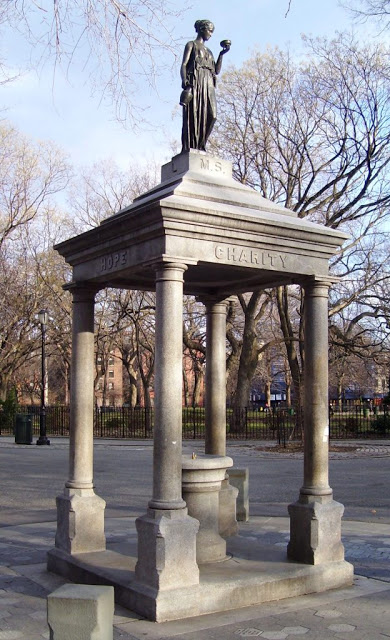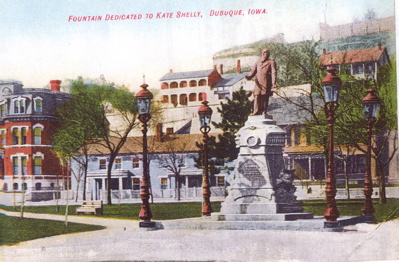Encyclopedia Dubuque
"Encyclopedia Dubuque is the online authority for all things Dubuque, written by the people who know the city best.”
Marshall Cohen—researcher and producer, CNN
Affiliated with the Local History Network of the State Historical Society of Iowa, and the Iowa Museum Association.
COGSWELL, Henry: Difference between revisions
No edit summary |
No edit summary |
||
| Line 5: | Line 5: | ||
[[Image:cogs.jpg|left|thumb|350px|Henry Cogswell's 1891 Temperance Fountain -- Tompkins Square Park ]]Cogswell had other motives in building the fountain. The statue he gave to Dubuque was one of fifty-one he had constructed around the United States beginning in 1878. (2) His belief was that if people had access to cool water they would not drink alcohol. (3) He had a goal of building one drinking fountain for every one hundred saloons in the United States. His fountains could be found in New York City; Buffalo, New York; and Boston, Massachusetts. The one in Washington, D.C. is known as the "Temperance Fountain." | [[Image:cogs.jpg|left|thumb|350px|Henry Cogswell's 1891 Temperance Fountain -- Tompkins Square Park ]]Cogswell had other motives in building the fountain. The statue he gave to Dubuque was one of fifty-one he had constructed around the United States beginning in 1878. (2) His belief was that if people had access to cool water they would not drink alcohol. (3) He had a goal of building one drinking fountain for every one hundred saloons in the United States. His fountains could be found in New York City; Buffalo, New York; and Boston, Massachusetts. The one in Washington, D.C. is known as the "Temperance Fountain." | ||
[[Image:imp550.jpg|left|thumb|350px|]]The fountain did not meet with a lot of local approval. Brewers did not like the inscription that promoted abstinence from alcohol by hailing "pure water for man and beast." The tall statue of the dentist-realtor was thought to be more of a memorial to himself than an honor of the heroic Iowan, Kate Shelley. | [[Image:imp550.jpg|left|thumb|350px|Washington Park statue.]]The fountain did not meet with a lot of local approval. Brewers did not like the inscription that promoted abstinence from alcohol by hailing "pure water for man and beast." The tall statue of the dentist-realtor was thought to be more of a memorial to himself than an honor of the heroic Iowan, Kate Shelley. | ||
One story claims an explosive was attached to the statue, but the cast iron weathered the blast. In 1900 a group of vandals pulled the statue from its base. It was thought they buried it under excavations for a new sidewalk. The next day concrete was poured over the site entombing the object it was believed. All visible remains of the statue were removed in 1912. | One story claims an explosive was attached to the statue, but the cast iron weathered the blast. In 1900 a group of vandals pulled the statue from its base. It was thought they buried it under excavations for a new sidewalk. The next day concrete was poured over the site entombing the object it was believed. All visible remains of the statue were removed in 1912. | ||
Revision as of 04:11, 23 January 2016
COGSWELL, Henry. (Tolland, CN, March 3, 1820 – July 8, 1900). Cogswell, a San Francisco dentist, made millions of dollars from his practice. A pioneer in his field, he designed the vacuum method of securing dental plates and was the first in California to perform a dental operation using chloroform. He invested wisely in real estate.
Cogswell claimed to have been a passenger on the train that Kate Shelley stopped in Iowa in 1881 during a rain storm. Her courage saved the lives of all the passengers. Nearly twenty years after the near accident, Cogswell donated a large metal sculpture of himself atop a large drinking fountain dedicated to Kate Shelley. The statue was dedicated on May 28, 1884 in WASHINGTON PARK. (1)
Cogswell had other motives in building the fountain. The statue he gave to Dubuque was one of fifty-one he had constructed around the United States beginning in 1878. (2) His belief was that if people had access to cool water they would not drink alcohol. (3) He had a goal of building one drinking fountain for every one hundred saloons in the United States. His fountains could be found in New York City; Buffalo, New York; and Boston, Massachusetts. The one in Washington, D.C. is known as the "Temperance Fountain."
The fountain did not meet with a lot of local approval. Brewers did not like the inscription that promoted abstinence from alcohol by hailing "pure water for man and beast." The tall statue of the dentist-realtor was thought to be more of a memorial to himself than an honor of the heroic Iowan, Kate Shelley.
One story claims an explosive was attached to the statue, but the cast iron weathered the blast. In 1900 a group of vandals pulled the statue from its base. It was thought they buried it under excavations for a new sidewalk. The next day concrete was poured over the site entombing the object it was believed. All visible remains of the statue were removed in 1912.
In 2007 when renovations were made to the park, efforts were made with metal detectors to find the statue. Nothing was located leading to the thought that the vandals had thrown the sculpture into the MISSISSIPPI RIVER.
---
Sources:
1. Way Back When," Telegraph Herald, Undated article. Courtesy: Diane Harris
2. "Henry Cogswell's 1891 Temperance Fountain -- Tompkins Square Park," Daytonian in Manhattan. Online: http://daytoninmanhattan.blogspot.com/2011/05/henry-cogswells-1891-temperance.html
3. Ibid.




